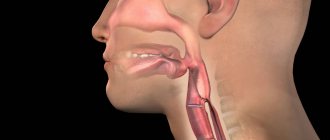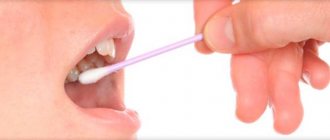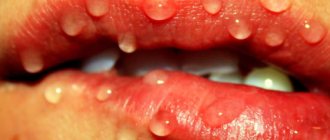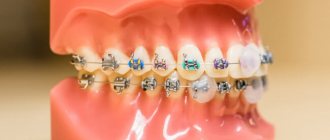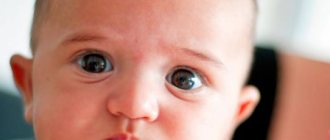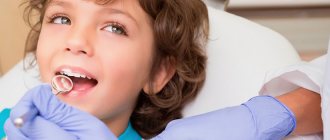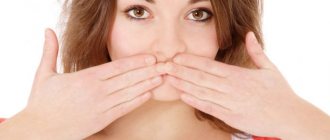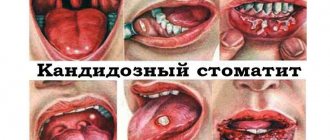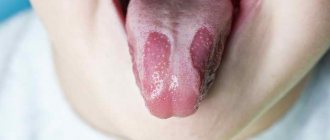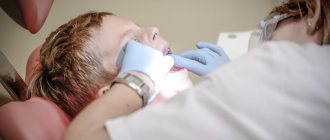May 8, 2020 Last revised: December 17, 2020 Oral diseases
The term “hypersalivation” in medicine usually refers to excessive constant drooling. It is also called ptyalism. This is normal in infants aged 3-6 months. In older children and adults, ptyalism is most often a pathology that doctors fight with varying degrees of success, depending on the reasons that caused this disease.
Hypersalivation in infants
A small person salivates profusely - a natural process. Or rather, involuntary. After all, a child still experiences discomfort from excessive dampness, and in order to get rid of it, he unconsciously gradually learns to somehow control his reactions.
He wanted to eat, began to cry and began to call his mother, saliva was released. But over time, it begins to stand out only from the moment he is put to the breast, not earlier.
It is bad when such hypertrophied salivation is observed at an older age, or even remains immediately after six months of the baby’s development.
Then ptyalism may be evidence:
- Amyotrophic lateral sclerosis.
- Neuroleptic syndrome.
- Epidemic encephalitis.
- Parkinson's disease.
Or be a companion to such a congenital disease as cerebral palsy.
A milder case is thrush, which can be easily suppressed with antibacterial or antifungal drugs that are harmless to children.
True, in the period from 6 months to 2 years, hypersalivation occurs as a companion to teething in a child, when the salivary glands cannot cope with the already developed reflexes. They themselves have just begun to function normally, and then a powerful irritating factor appears in the form of unusual objects next to them.
A particularly strong reaction is observed in three pairs of the most efficient glands: submandibular, sublingual parotid. But small salivary glands located on the tongue, on the epithelium of the inner side of the cheeks, and the palate of the lips also contribute to abundant salivation. Moreover, in the characteristics of saliva, all the variety of secretions is noted, from serous to mucous, mixed and in pure form.
And all this “wealth” makes a person literally choke on saliva. And at a young age, when control habits have not been developed or this cannot be done due to physiological characteristics, saliva is not retained in the mouth, flowing out.
At a conscious age, if everything is in order with the intellect of a child (and even more so of an adult), such a pathology, with the awareness of it as an aesthetic defect, becomes a source of worry and anxiety, and certainly requires treatment.
Teething period
Teething usually begins around 6 months of age. The child becomes whiny and irritable. The process of tooth extraction is accompanied by pain and the formation of wounds on the gums. They can greatly disturb the baby, bringing him a lot of suffering.
Salivation helps make pain less intense: saliva has an anti-inflammatory and calming effect. Teething is greatly extended over time and sometimes lasts up to 2 (and even 3) years.
Important! Increased salivation up to 2 years of age is most often caused by natural causes and is physiological.
Causes of the disease
- The body's protective reaction to the presence of a foreign body in the mouth. Or the presence of objects that the body perceives as foreign at first (growing teeth, installation of dentures or implantation of implants in the gums, which can cause hypersalivation in adults). This condition is temporary and does not require treatment. It is considered as an unconditional reflex increase in the production of salivary gland secretions and a protective reaction of the body.
- Hypersalivation of a different etiology, including congenital nature. Or acquired as a result of injuries, infections or factors that caused developmental failure. Then, in the treatment of pathology, the emphasis is on eliminating the disease-cause that caused ptyalism. Or mitigating the consequences of the disease that caused it.
- Diseases of the nervous system of various etiologies, including those caused by traumatic or infectious damage to the brain.
- Diseases of the oral cavity that have a dental coloring: gingivitis, stomatitis, sialadenitis, or inflammation of the salivary glands.
- For diseases associated with the gastrointestinal tract: pancreatitis, gastritis, ulcers (stomach and duodenum).
- Cerebral infections in the form of rabies or tick-borne encephalitis (the first is deadly without timely administered serum).
- Neurological disorders in the form of brain tumors, strokes, bulbar palsy, cerebral palsy, developmental delays, schizophrenia, psychosis, hysteria with motor hyperactivity, trigeminal neuritis.
- Poisoning by metals or halides.
- Worms in such quantities that their waste products cause poisoning of the body.
- Lack of nicotinic acid in the diet.
- The use of M-cholinomimetics, lithium salts, anticonvulsants, even in cases where they are indicated in the treatment of concomitant diseases, but the consequences of hypersalivation have not been calculated.
Increased salivation (hypersalivation) in children: a problem for doctors and parents.
On the Siberian Medical Portal (https://www.sibmedport.ru) I was recently asked a question about increased drooling in a child aged 2.5 years: “Drooling constantly, not only when he starts playing or thinking and opens his mouth, but in general “Whenever you tell him and remind him that he needs to swallow his saliva, he swallows, understands this, and has been swallowing food normally for a very long time.”This pressing question is very difficult to comment on, but I will still try to answer it.
Hypersalivation, synonyms: ptyalism, sialorrhea, drooling
- This is an increase in the secretory activity of the salivary glands. In children aged the first two years of life, this phenomenon is considered physiological during the eruption of the first (baby) teeth.
In older children, hypersalivation is regarded as a disease that brings a lot of trouble, anxiety and discomfort to the child and parents.
In such children, first of all, a disturbed swallowing reflex is observed, and not a true increased production of saliva, which is commonly called hypersalivation, which is noted in the following pathological conditions:
- stomatitis (pathology of the oral mucosa);
- viral diseases affecting the salivary glands (viral sialadenitis);
- diseases of the gastrointestinal tract (pancreatitis, peptic ulcer, etc.)
- helminthic infestation;
- diseases of the central nervous system (cerebral palsy (cerebral palsy), bulbar palsy, Parkinson's disease, encephalitis of various natures (etiologies); lateral myographic sclerosis, brain tumors, strokes, some forms of schizophrenia, etc.);
- nervous stress, strong psychological and emotional experiences (positive, for example, from anticipation of something tasty, or, conversely, negative);
- poisoning with lead, mercury, barbiturates, organophosphorus substances (karbofos, chlorophos, etc.).
Clinical manifestations
are expressed in a complaint about the abundance of saliva in the oral cavity and the need to constantly spit it out.
A functional study of the salivary glands (sublingual, parotid glands) with true hypersalivation reveals an increase in the amount of secretion (saliva) above the norm of more than 10 ml in 20 minutes (normally within 1-4 ml). No other pathology of the salivary glands is determined.
“Relative” or false hypersalivation occurs against the background of a violation of the act of swallowing (with an inflammatory process in the oral cavity, injury to the tongue, neurological pathology - bulbar palsy, etc.). In these cases, the amount of saliva produced corresponds to the above standards, but the patient and parents have a false feeling of its excess.
Treatment
consists of adequate treatment of the underlying disease that caused hypersalivation.
Irritation of the mucous membrane during acute inflammatory processes occurring on the oral mucosa is accompanied by an unconditional reflex increase in saliva secretion, which is a protective reaction of the body. In such cases, hypersalivation does not require treatment.
In the treatment of true hypersalivation, drugs with an anticholinergic effect are used (m-anticholinergics - atropine, antispasmodic, typhen, aprofen, diprofen, metacin, etc.). They reduce saliva production but have other serious side effects.
M-anticholinergics include belladonna alkaloids (atropine, scopolamine) and platyphylline; synthetic drugs similar in structure (for example, homatropine) and some other tertiary and quaternary ammonium compounds (aprofen, metacin, etc.). By blocking m-cholinergic receptors in organs, these drugs cause dilation of the pupils, paralysis of accommodation, increased intraocular pressure, inhibit the secretion of saliva, sweat and secretion of the glands of the stomach and intestines, increase the rhythm of heart contractions, and relax the smooth muscles of the bronchi and stomach.
Surgical treatment and radiation are also used, but these methods threaten serious complications: facial asymmetry, caries, etc.
Treatment methods such as biofeedback therapy (biofeedback) and exercises for the muscles in this area are not effective enough to cope with the problem of ptyalism.
In children, increased salivation can cause a violation of the pronunciation side of speech - the so-called dysarthria, when a large amount of saliva prevents children from mastering and pronouncing words. This can lead to the formation of slurred speech, which will further complicate the child’s development and socialization. Therefore, this problem must be solved together with a qualified speech therapist to conduct speech therapy massage.
So, in each specific case, it is necessary to ask yourself the question: “What is the cause of increased drooling?”
P. _ S. _
From the physiology of salivation and salivation it is known that when the oral mucosa is filled with saliva, peripheral receptors transmit this information along sensory nerve fibers to the brain, and from the brain along the motor (descending) pathways the command to swallow saliva is transmitted.
Now let’s remember our feelings after visiting the dentist, who gave us light pain relief (anesthesia). It seems that if you lose sensitivity in your lips, you will begin to drool. To avoid hypersalivation, the patient has to monitor the swallowing of saliva. This effect occurs because the reflex sensorimotor arc is temporarily blocked by anesthesia, and information from the oral cavity does not enter the brain.
Drooling in children with various of the above pathologies is caused by various factors. However, they all lead to disturbances at the level of the sensorimotor arc, i.e. associated with sensory disturbances. This is the main cause of drooling.
Thus, children suffer from reduced sensation (hypoesthesia), but not anesthesia (complete loss of sensation), and therefore there are significantly fewer spontaneous swallows during the day. This explains the increased salivation.
In the presence of such hypersalivation, rehabilitation should be aimed not at regularly reminding the child of the need to voluntarily swallow saliva (especially since this cannot be done constantly), but at correcting the sensorimotor arc.
To do this, you need to create a situation to provide the brain with more information that allows for reflexive swallowing. For these purposes, foreign scientists use cryotherapy (from the Greek word krios, i.e. cold) in the form of running an ice stick across the tongue. This method of rehabilitation does not give results in 100% of cases, however, in half of the cases of hypersalivation, there is a cessation of salivation or a clear decrease in it.
Of course, this method takes quite a long time to expect a positive result (such work must be carried out over several months) and is labor-intensive for parents. However, such a conditioned reflex technique is not traumatic for the child compared to methods of surgical dental correction of facial muscles, which do not give better results over a longer period of observation.
And one last thing. If hypersalivation occurs, care should be taken to increase the child's fluid intake during the day to compensate for the daily loss of fluid (water).
02/25/2012
Timoshenko V.N.
, pediatrician of the highest qualification category,
Candidate of Medical Sciences, Associate Professor
More articles on the topic:
Types of hypersalivation
Both in older children (not infants) and in adults, hypersalivation can be based on two mutually exclusive mechanisms:
- The salivary glands increase their secretion, producing more than 2 and a half liters per day. This type of salivation is called true hypersalivation.
- Another type (false hypersalivation) manifests itself in a violation of the processes of swallowing saliva, when it is produced no more than normal. This type of disease, without intensification of salivary processes, occurs 3-4 times more often than the first type.
Drug hypersalivation
Intense salivation is caused by drugs with lithium or nitrazepam, which, in turn, can provoke xerostomia with a severe wound.
Xerostomia is a critical deficiency of salivary secretion, usually occurring with an overdose or too long exposure of the body to drugs during the treatment of hypersalivation. Symptoms of xerostomia are dry mouth, burning of the lips and tongue, angular cheilitis in the corners of the mouth (“jams”), dry red border on the lips with the formation of crusts and bleeding microcracks, “folded tongue.”
Sialodohit
This inflammation of the salivary ducts, as an independent disease, also often causes hypersalivation. It happens in older people, and even more often in old age. A constant companion of sialodochitis is the appearance of painful microcracks in the corners of the mouth.
Salivation during sleep
There have been many cases where copious salivation occurs only during sleep. The causes of nighttime drooling in adults were:
- Improper daily routine with chronic fatigue syndrome, when sleep resembles loss of consciousness.
- Infestations of worms with their excessive reproduction.
- Reduced acidity of gastric juice with gastritis.
- Malocclusion.
- Missing one or more teeth in the mouth.
- ENT diseases that make breathing difficult during sleep. In this case, the oral mucosa quickly dries out, and the mechanism of focal compensation is activated, when some salivary glands begin to work several times more actively.
A special case is ptyalism in women during pregnancy, which is based on purely physiological reasons. It develops against the background of changes occurring in the gastrointestinal tract, and most often in the first trimester of pregnancy. May be accompanied by severe heartburn, nausea, and vomiting.
Psychogenic course of the process
It is extremely rare, but it is even more difficult to treat than traumatic or infectious lesions. With this type of hypersalivation, any signs of damage to the nervous system and inflammatory processes may be completely absent. But salivation in this case is even more abundant than with injuries and infectious lesions. To such an extent that those suffering from this form of hypersalivation have to carry a saliva bag with them.
The problem can only be solved by surgical methods or the use of radiology or cryotechnology.
Bulbar and pseudobulbar syndromes
The amount of saliva produced during bulbar pseudobulbar syndrome depends only on the severity of the processes occurring during the disease. Pathologies include syringobulbia, poliomyelitis, degenerative diseases, and vascular diseases.
In extreme cases of the disease, saliva output can reach 1 liter per day. This course of the disease not only dehydrates the body, but deprives it of many elements, since saliva itself is an infiltrate of blood and lymph. The need to constantly carry a saliva collector or towel with you to collect secretions does not contribute to psychological comfort and looks anti-aesthetic.
Dental pathologies
Radiotherapy can be used as a radical treatment. But sometimes the very fact of irradiation can also provoke hypersalivation. Dental pathology is also possible with ulcerative stomatitis, toxicosis of any nature and helminthic infestations.
In all these cases, both conservative treatment with therapeutic methods (only with the use of potent drugs) and surgical intervention are possible.
Drooling at 2–3 months
At the age of about 2 months, a baby may experience profuse salivation, caused by the fact that the salivary glands finally begin to work at full capacity. It is at this age that a child may need his first bib to protect his clothes from getting wet.
The mother also needs to very carefully monitor the condition of the child’s skin, especially the area around the lips and chin. Excessive saliva can irritate baby's delicate skin. To prevent this from happening, it is recommended to lubricate the area around the mouth with baby cream or Vaseline.
Inflammation of the submandibular salivary gland
Closer to 3 months, children become active explorers of the world around them and taste everything. They put fingers, toys and any other objects at hand into their mouths.
The baby's body becomes acquainted with new microflora, which leads to increased secretion of saliva, which performs a protective function. At this age, increased saliva production can also occur against the background of an acute respiratory disease.
Breathing through the nose becomes difficult, and the child has to breathe through the mouth. This causes the nasopharynx to dry out and reflexively release a larger amount of saliva than usual, which moisturizes the air and disinfects it.
Symptoms
All cases of increased salivation should be the basis for close medical supervision. The doctor must pay attention to how the patient behaves: whether he swallows saliva or the process of its secretion is not controlled by the patient. In the second case, this process is most often not controlled, and its consequences are redness of the skin at the corners of the mouth and a pustular rash. In their sleep, such people usually get their pillow wet with saliva. Children have constantly wet clothes, especially in the chest and collar area.
Diagnostics
Diagnosing hypersalivation does not cause difficulties; it is much more difficult to find out the cause of its occurrence. To do this, carefully collect anamnesis, then examine the functional activity of the salivary glands. With true hypersalivation, the patient secretes over 10 ml of saliva in 20 minutes (the norm is from 1 to 4 ml).
The salivary glands of an adult secrete about 2 liters of saliva per day. Normally, it does not leak from the oral cavity.
Depending on the medical history and initial examination, the patient is referred for consultation to specialized specialists (gastroenterologist, dentist, neurologist, infectious disease specialist, psychiatrist).
Etiotropic therapy for hypersalivation is aimed at the primary disease, the symptom of which is increased salivation.
To reduce saliva secretion the following are used:
- rinsing the mouth with astringent solutions (for example, a decoction of oak bark);
- drugs from the group of anticholinergics or anticholinergics.
If treatment for hypersalivation is ineffective, in severe cases they resort to irradiation of the salivary glands or their surgical removal.
In cases where hypersalivation is caused by weakness of the facial muscles, massage and special exercises are prescribed.
Also, in order to relieve persistent hypersalivation, they resort to injections of botulinum toxin (Botox) into the tissue of the parotid salivary glands. This procedure can be performed on an outpatient basis, as it is accompanied by an extremely low rate of complications. The effect of a single injection of Botox lasts for 6-8 months, after which the injections are repeated.
As a physiological phenomenon, ptyalism is observed in children in the first half of life.
Diagnosis of hypersalivation
The nature of increased salivation is clarified, what preceded it, what painful sensations (if any) were accompanied. All accompanying symptoms are recorded.
The swallowing ability itself is checked, with the participation of a dentist or after his consultation, a conclusion is made about the condition of the oral cavity.
Testing the functioning of the salivary glands using typical reflexes. The amount of saliva secreted in a calm state is determined. If more than 10 ml of saliva is released in 20 minutes, this can be considered abnormal.
Based on the results of the examination, the patient can be sent to specialized specialists: dentist, gastroenterologist, neurologist.
The dentist diagnoses the presence or absence of gingivitis, caries, stomatitis, as well as the need for dentures or braces.
The neurologist will deal with possible acquired nervous disorders of an infectious or traumatic nature.
A gastroenterologist examines the secretory functions of the salivary glands in the light of their interaction with the digestive organs. It is not so rare that problems with intense salivation are associated specifically with the gastrointestinal activity of the body.
For an accurate diagnosis, clarifying procedures may be prescribed in the form of the following laboratory tests:
- Polymerase chain reaction.
- Cytological analyses.
- Biological analyses.
- Biopsies of glandular tissue.
- Immune tests.
- Analyzes related to microbiological activity in the glandular area.
Increased salivation after 5 years
If a symptom bothers a child at an older age, after 5 years, then this may be a cause for concern on the part of the parents. There are a number of reasons why saliva is produced in large quantities:
- inflammation in the oral cavity (stomatitis, gingivitis, candidiasis);
- infections of the upper respiratory tract and nasopharynx (for example, with adenoids, copious amounts of saliva are produced at night and prevent the baby from sleeping);
- disturbances in the gastrointestinal tract (gastritis, duodenitis, pancreatitis);
- helminthic infestations;
- poisoning with drugs, as well as toxic substances and household chemicals (a life-threatening condition - requires immediate medical attention);
- diseases of the nervous system (especially with damage to the central nervous system, some forms of cerebral palsy, congenital malformations).
If there is increased drooling of any etiology, it is best to show the child to a doctor. Only he will be able to determine the true cause of the symptom and, if necessary, prescribe additional examinations.
Treatment
It is selected based on the medical history and consists of eliminating the root cause of the disease. If hypersalivation is associated with gastritis, then to eliminate dyspeptic symptoms, drugs are prescribed that increase the acidity of gastric juice.
The dentist will use antiseptic solutions. In his case, dental problems will be detected with a change in the microflora of the oral cavity towards intensive proliferation of bacteria in soft deposits on the teeth. And these soft deposits in the near future will not only cause the formation of tartar, but will also aggravate the existing hypersalivation.
Standard Actions
- Use anticholinergics - drugs that reduce the secretory activity of the salivary glands.
- For adults, it is possible to use biofeedback therapy if the importance of auto-training can be conveyed to the patient.
- As a radical remedy, surgery can be used to remove the most active and large glands.
- Cryotherapy as a type of surgical intervention. Only instead of a scalpel, extremely low temperatures inherent in liquid nitrogen are used.
- Radiotherapy with irradiation with a directed narrow beam of gamma radiation, suppressing the activity of the salivary gland selected for this.
- Injection of botulinum toxin into the parotid glands. This allows you to block their activities for 6-8 months.
Treatment of pregnant women
Radical methods with them are unacceptable, therefore palliative methods of influencing the salivary glands are used:
- Small doses of atropine to suppress salivary secretion.
- Exclusion from the diet of foods high in starch or acids - even such beneficial ones as ascorbic acid.
- Constant use of mouthwashes with menthol or sage infusions.
Any treatment method may have contraindications or cause side effects. There have been cases when, in order to get rid of the causes and symptoms of this disease, it was enough for the patient to change the diet, excluding from it substances that irritate some body systems or, conversely, introducing them into the menu.
Sometimes increased physical activity helped get rid of excessive salivation syndrome. And sometimes - an exception from the list of habits of caffeine, alcohol and smoking.
Sialorrhea as a symptom of neurological disorders and diseases
Normally, salivation occurs around the clock, increasing slightly under the influence of certain irritants: aromas and type of food.
Typically, 2 ml of secretion accumulates in the mouth within 10 minutes. If saliva is produced excessively during the same period, its volume is 5 ml or more.
Sialorrhea (ptyalism) is an overproduction of the secretion of the salivary glands; this condition is physiological for children in the first year of life; in adults, hypersalivation indicates a neurological or other pathology.
Excessive salivation creates a lot of discomfort and dissatisfaction.
Folk remedies for treating hypersalivation
In mild cases, hypersalivation can be treated with folk remedies:
- Decoctions of water pepper and fruits with Shepherd's purse seeds. Used for intensive mouth rinsing.
- Decoctions of viburnum berries, without added sugar.
- Lemon. The slices are chewed along with the zest, the essential oils of which also have a beneficial effect on possible lesions in the mouth.
- Chamomile – both ordinary meadow chamomile and pharmaceutical chamomile. Pharmacy, due to its greater activity, is used in decoctions of lower concentrations.
Doctors do not recommend using folk remedies without consulting them, since the patient may not know the full picture without a detailed medical examination. Such treatment methods can only be effective in combination with medications, serving as a supporting and mitigating factor.
Hypersalivation
Hypersalivation (salivation, ptyalism) is an increased production of secretion by the salivary glands, that is, saliva. As a physiological phenomenon, ptyalism is observed in children in the first half of life. At any other age, increased secretion of saliva indicates one or another pathology.
The salivary glands of an adult secrete about 2 liters of saliva per day. Normally, it does not leak from the oral cavity; there should also be no need for frequent swallowing or spitting.
Many diseases of different organs can lead to hypersalivation:
- diseases of the digestive system (stenosis of the esophagus, gastritis, peptic ulcer of the stomach and duodenum, acute and chronic pancreatitis);
- diseases of the oral cavity (sialoadenitis, gingivitis, stomatitis, cheilitis);
- diseases of the nervous system (stroke, Parkinson's disease, brain tumors, inflammation of the trigeminal or facial nerve, bulbar palsy, vagotonia, neuroses);
- mental illness (psychosis, some forms of schizophrenia, mental retardation);
- infectious diseases (rabies, polio, botulism, diphtheria);
- helminthic infestations (nematodes, cestodes, trematodes);
- hypovitaminosis of vitamin PP (nicotinic acid);
- poisoning with tin, copper, chlorine, bromine, iodine, mercury.
Hypersalivation can develop as a side effect of taking certain groups of medications:
- lithium salts;
- M-cholinomimetics;
- anticonvulsants (anticonvulsants).
Depending on the mechanism of development, hypersalivation occurs:
- True - associated with increased secretion of the salivary glands.
- False (pseudohypersalivation) is the result of a violation of the mechanism of swallowing saliva (against the background of sore throat, lesions of the facial nerve, cerebral palsy, etc.).
In severe cases of hypersalivation, patients experience damage to the skin of the face associated with the irritating effect of saliva.
In accordance with the cause that caused true hypersalivation, there are:
- bulbar and pseudobulbar hypersalivation, that is, manifested in bulbar and pseudobulbar syndromes in cerebral vascular pathology, neurodegenerative diseases, poliomyelitis, etc.;
- somatic – caused by somatic pathology. Observed during radiation therapy, toxicosis of pregnancy, ulcerative stomatitis, helminthiasis, and a number of malignant tumors;
- medicinal – a side effect of therapy with lithium or Nitrazepam;
- psychogenic - this is the rarest type, develops under the influence of psychotraumatic factors, and sometimes the cause cannot be identified.
Treatment of childhood hypersalivation
If hypersalivation is detected in a very young child, then getting rid of it, of course, is a labor-intensive task.
- Teach your baby to keep his lips closed. This also involves learning to swallow saliva in a timely manner - if this does not cause nausea or a similar negative reaction.
- Teach your child how to control dry chin. Often young children do not pay attention to this sign, considering it, apparently, natural. During training sessions it is worth taking short breaks. And the classes themselves should be conducted in the form of games, which can be taught by a pediatrician; the appropriate methods have long been developed.
To treat childhood hypersalivation you can use:
- Applying ice to points around the lips and along their contour.
- The use of decoctions of medicinal herbs for rinsing.
- Gymnastics of articulatory muscles.
- Massages performed by a speech therapist.
- Consumption of solid foods that require intensive chewing or gnawing: apples, nut kernels, carrots, rye crackers.
Therapy in children
Treatment of hypersalivation in children consists of:
- Cold therapy. A piece of ice is applied to the contour of the lips in various areas for a few seconds.
- Rinsing the mouth with herbal decoctions. Rose hips, oak bark, and yarrow are suitable. Before the procedure, you must make sure that the child is not allergic to the active ingredients.
- Speech therapy massage of the submandibular fossa, jaw closing area, palate.
- Introduction of solid foods into the diet.
- Mimic and articulatory gymnastics.
Hypersalivation in children often occurs during teething.
Important! Children should be reminded to swallow saliva and keep their mouth closed when not eating or talking. It is necessary to teach your baby to distinguish between the sensations of a wet and dry chin.
What is hypersalivation (ptialism)? Symptoms and treatment
Hypersalivation (salivation, ptyalism) is a disease in which there is an excessive increase in salivation caused by an increase in the activity of the secretory function of the salivary glands. In babies under six months of age, increased production of saliva in the oral cavity is considered normal; in other cases, excessive drooling is considered to be a manifestation of some disease or pathology.
Ptyalism can be false or true. With false hypersalivation, the patient has the impression that saliva is being produced more than usual, although in reality the volume of secretion remains at the same level. This is usually associated with a swallowing disorder. With the true type of disease, the amount of saliva secreted actually exceeds the normal volume several times.

